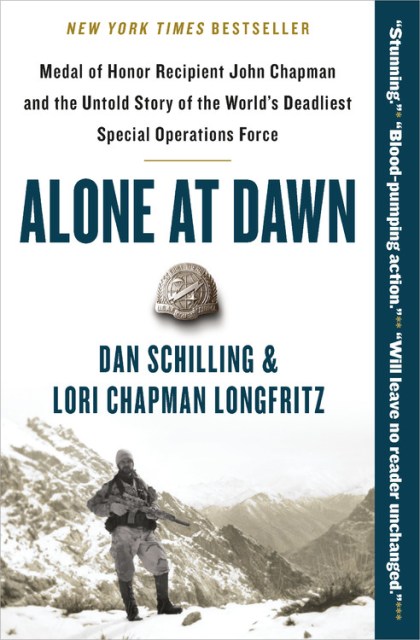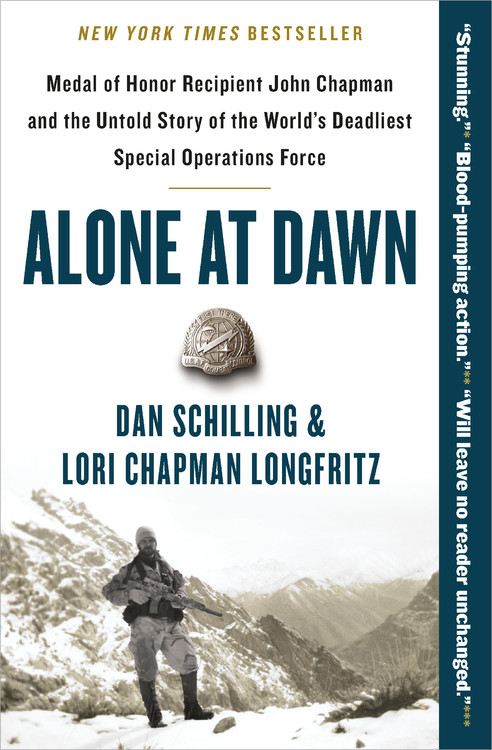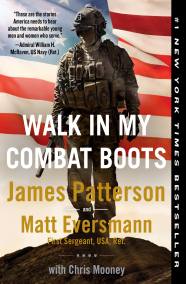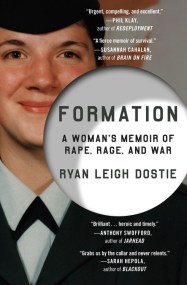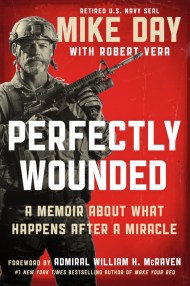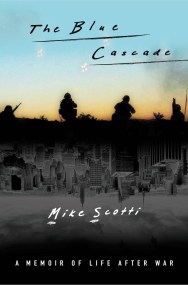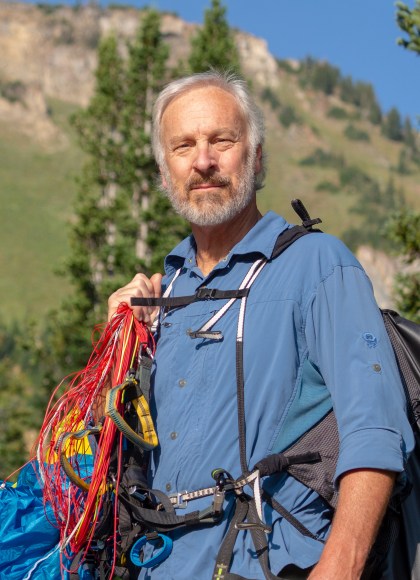Promotion
Use code MOM24 for 20% off site wide + free shipping over $45
Alone at Dawn
Medal of Honor Recipient John Chapman and the Untold Story of the World's Deadliest Special Operations Force
Contributors
By Lori Longfritz
Formats and Prices
Price
$17.99Price
$22.99 CADFormat
Format:
- Trade Paperback $17.99 $22.99 CAD
- ebook $14.99 $19.99 CAD
- Hardcover $30.00 $39.00 CAD
- Audiobook Download (Unabridged)
This item is a preorder. Your payment method will be charged immediately, and the product is expected to ship on or around June 23, 2020. This date is subject to change due to shipping delays beyond our control.
Also available from:
The New York Times bestselling true account of John Chapman, Medal of Honor recipient and Special Ops Combat Controller, and his heroic one-man stand during the Afghan War, as he sacrificed his life to save the lives of twenty-three comrades-in-arms.
In the predawn hours of March 4, 2002, just below the 10,469-foot peak of a mountain in eastern Afghanistan, a fierce battle raged. Outnumbered by Al Qaeda fighters, Air Force Combat Controller John Chapman and a handful of Navy SEALs struggled to take the summit in a desperate bid to find a lost teammate.
Chapman, leading the charge, was gravely wounded in the initial assault. Believing he was dead, his SEAL leader ordered a retreat. Chapman regained consciousness alone, with the enemy closing in on three sides.
John Chapman’s subsequent display of incredible valor — first saving the lives of his SEAL teammates and then, knowing he was mortally wounded, single-handedly engaging two dozen hardened fighters to save the lives of an incoming rescue squad — posthumously earned him the Medal of Honor. Chapman is the first airman in nearly fifty years to be given the distinction reserved for America’s greatest heroes.
Alone at Dawn is also a behind-the-scenes look at the Air Force Combat Controllers: the world’s deadliest and most versatile special operations force, whose members must not only exceed the qualifications of Navy SEAL and Army Delta Force teams but also act with sharp decisiveness and deft precision — even in the face of life-threatening danger.
Drawing from firsthand accounts, classified documents, dramatic video footage, and extensive interviews with leaders and survivors of the operation, Alone at Dawn is the story of an extraordinary man’s brave last stand and the brotherhood that forged him.
Genre:
-
"The men who wear the Medal of Honor do so on behalf of all Americans-past, present, and future-who serve their country. I'm certain that if John Chapman had survived the events that led to his Medal, he would be uncomfortable with being singled out as a hero. But the fact is, that day he saved many lives at the cost of his own, and dozens of families owe the safe return of their loved ones to him. Every American should know this story. Thanks to Alone at Dawn, the first comprehensive account of his one man stand in Afghanistan, we have a chance to celebrate John Chapman's life and the courageous work of his fellow Air Force Combat Controllers."ClintonRomesha, Medal of Honor recipient and New York Times bestselling author of Red Platoon
-
"Alone at Dawn is a stunning portrayal of a true American hero, from an unknown unit of unsung acclaim, and consisting of unassuming patriots. John Chapman, Medal of Honor recipient, exemplifies all the traits of the most decorated wing in the U.S. Air Force."Lt.Gen. Kurt A. Cichowski, USAF (Ret), former Assistant Director, CIA
-
"A blend of military history, wartime drama, and the incredible true story of Sergeant John Chapman-the first Air Force Medal of Honor recipient since the Vietnam War-Alone at Dawn delivers blood-pumping action, heart-warming kindness, and an insider account of the most courageous individuals on the planet. Dan Schilling makes epic military heroism come alive and reminds us what true purpose is all about; and Lori Longfritz, John's sister, offers a poignant perspective on her brother's life, which was extraordinary long before his heroic one-man stand."DeborahLee James, 23rd secretary of the US Air Force
-
"Alone at Dawn is riveting and powerful. This stunning account reveals for the first time one of the most extraordinary acts of valor and courage in the annals of U.S. history. With this book, USAF CCT John Chapman now rightfully takes his place as an iconic hero of the Afghanistan War. All Americans should honor and enshrine the memory of such undaunted self-sacrifice and valor."Lt.Col. Dave Grossman, USA (Ret.), author of On Killing, On Combat, and AssassinationGeneration
-
"A long-overdue account not just of one hero but an entire force of heroes. Documenting Chapman's final mission, Schilling and Longfritz recreate the blood-soaked, desperate battle in all its dramatic detail, then fearlessly delineate the most terrible choice combat can demand. It's a story that will upset some and inspire many, but will leave no reader unchanged."Jim DeFelice, coauthor of the #1 NewYork Times bestselling American Sniper
-
"Alone at Dawn is inspired by the life and heroism of Medal of Honor recipient John Chapman. The genius of the book is that readers will also learn what a Combat Controller does, and why every team of Delta, SEALS, and Green Berets want their Air Force Special Tactics professionals with them whenever they engage in battle. The men on Takur Ghar, where seven Americans were killed in action in service to their country, were doomed by classic examples of senior military incompetence and inter-service rivalry. That terrible tragedy will never diminish the bravery of those who fought on and above the mountain in March of 2002, and those who made the ultimate sacrifice, especially MSgt John Chapman, USAF."James G. Roche, 20th secretary of theAir Force
-
"A brave book about a brave warrior and the long overdue acknowledgment of the history and the contributions made by the men of the 24th Special Tactics Squadron (aka Air Force Combat Controllers)."Pete Blaber, former commander Delta Force and author of The Mission, The Men, and Me
-
"This is a story of heroism of not only of one man, John Chapman, but a heroic breed of American warriors-Air Force Combat Controllers. It is a gripping account of Chapman's last moments and pays homage to a brotherhood dedicated to keep America safe and free."Dr. Robert Kadlec,Assistant Secretary for Preparedness & Response, Former Deputy StaffDirector, Senate Select Committee on Intelligence and Special Assistant toPresident George W. Bush
-
"As one of our nation's most elite special operations forces, Combat Controllers not only jump, dive, shoot, and maneuver with the best, they uniquely combine these skills with absolute mastery of three-dimensional battlespace to deliver lethal and precision airpower, making them the deadliest force on any battlefield. Among even this exceptional and select brotherhood, John Chapman's heroism on Takur Ghar is without equal in America's longest war."LtGen Donny Wurster, USAF (ret), former commander, Air Force Special OperationsCommand
-
"The men who serve in Combat Control whose incredible story is presented in this book aren't asking for recognition. No late night talk show, video game or film could possibly begin to convey the intensity of the experience, the fear, the sense of duty and valor, the bonds that unite these men and, above all, the inner feelings and motivation of someone who has stepped up and accepted the challenge of this toughest of Missions."Jeffrey"Skunk" Baxter, musician, national security specialist
-
"In this informative and sometimes moving account, author and military veteran Schilling and Longfritz pay tribute to Longfritz's brother, Medal of Honor winner John Chapman . . . The pacing heightens the tale's immediacy, and reconstruction of Chapman's inner experience packs an emotional punch. This paean to heroism will strike a chord with fans of combat narratives."Publishers Weekly
-
"This is an excellent book about a modern-day hero in a military field that rarely makes the front page."Booklist
- On Sale
- Jun 23, 2020
- Page Count
- 352 pages
- Publisher
- Grand Central Publishing
- ISBN-13
- 9781538729663
Newsletter Signup
By clicking ‘Sign Up,’ I acknowledge that I have read and agree to Hachette Book Group’s Privacy Policy and Terms of Use
